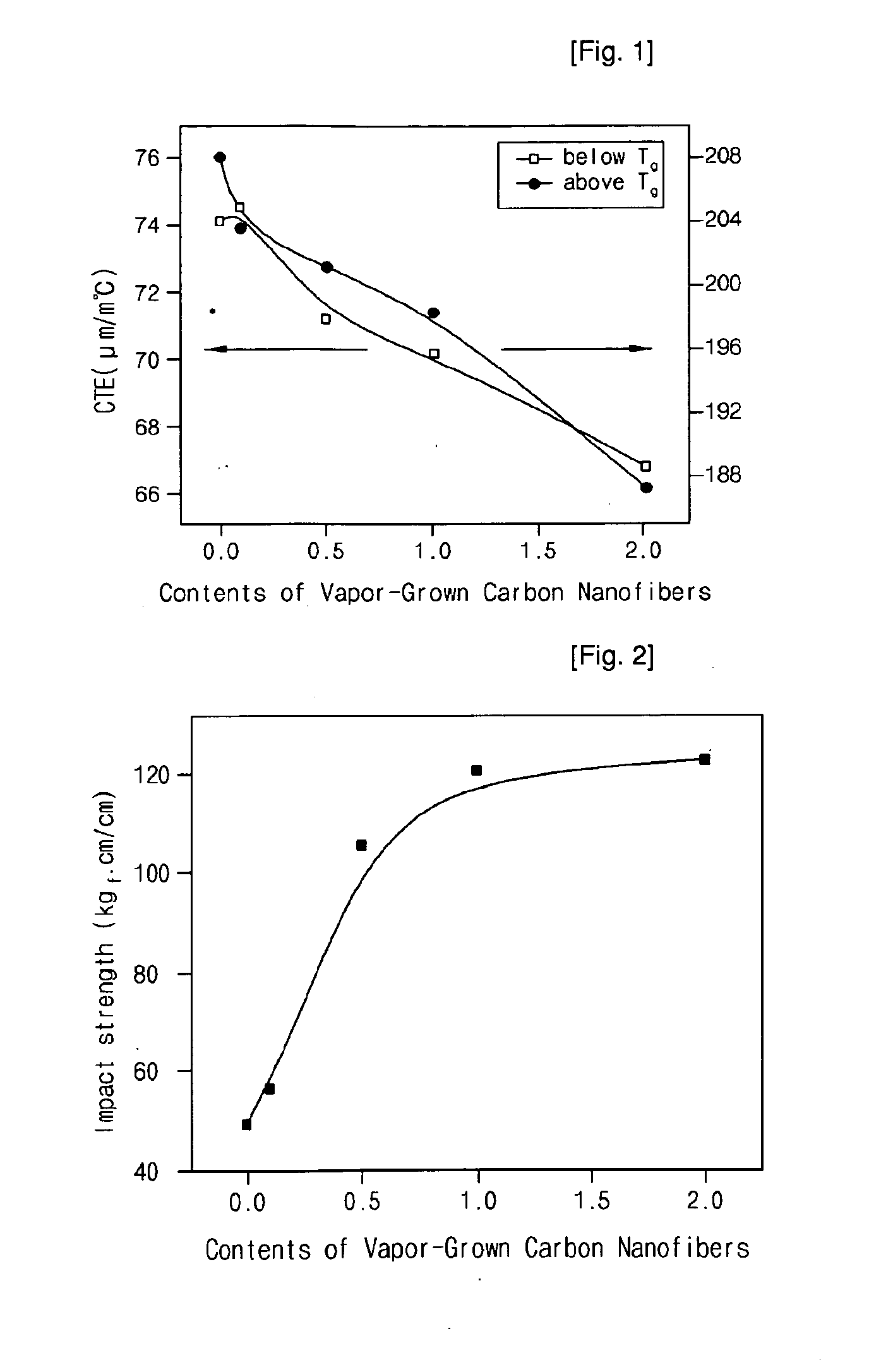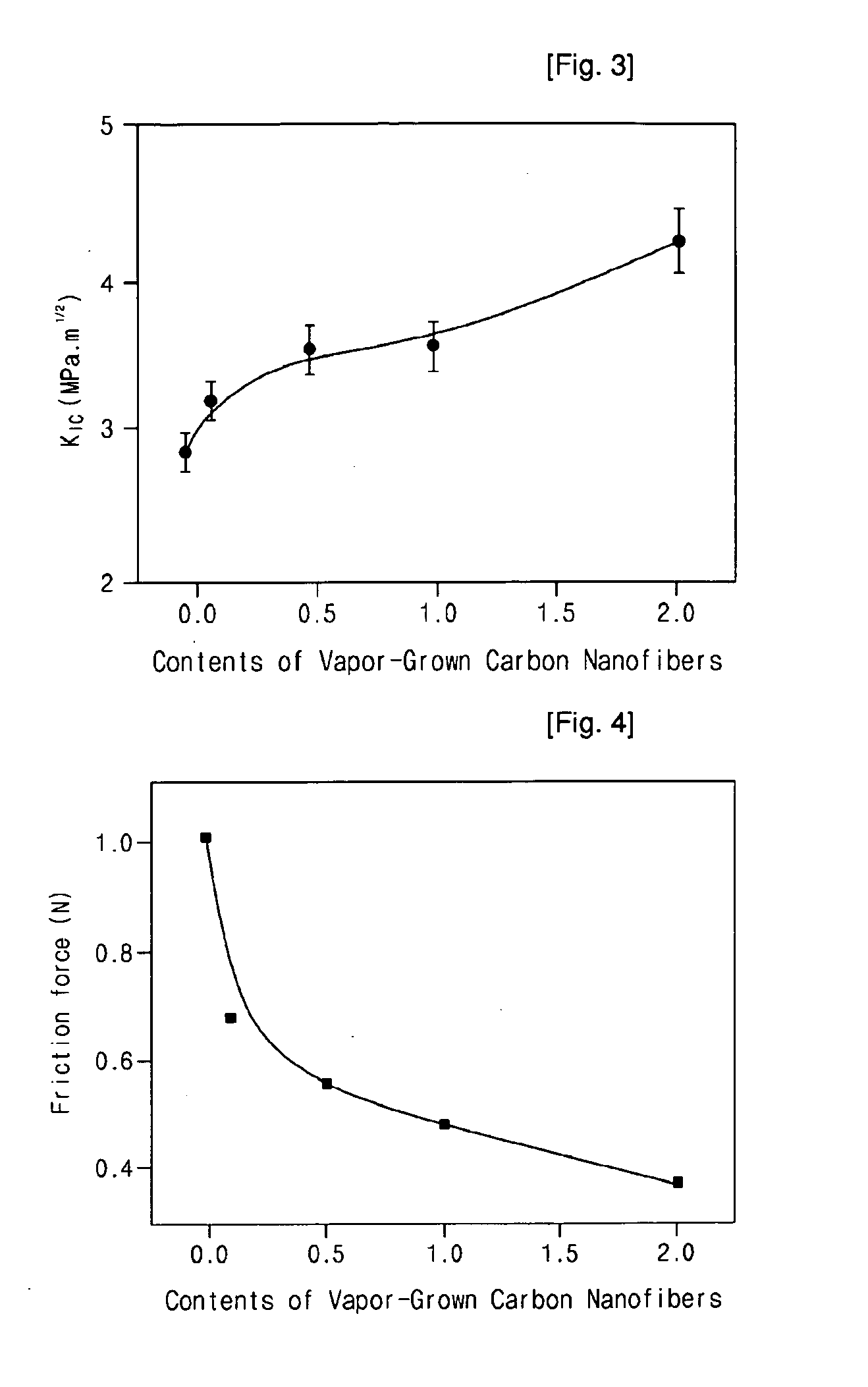Method for manufacturing epoxy nanocomposite material containing vapor-grown carbon nanofibers and its products thereby
a technology of carbon nanofibers and nanocomposite materials, which is applied in the field of epoxy nanoparticle materials containing vapor-grown carbon nanofibers, and the production of nanocomposite materials thereby, can solve the problems of reducing the mechanical properties of the resulting polymer composite materials, unable to achieve electrical conductivity, and unable to meet the requirements of abrasion resistance, etc., to achieve excellent mechanical strength, excellent dispersion, and low friction/wear.
- Summary
- Abstract
- Description
- Claims
- Application Information
AI Technical Summary
Benefits of technology
Problems solved by technology
Method used
Image
Examples
example 1
[0037]Vapor-grown carbon nanofibers (Showa Denko) having a mean diameter of 100-200 nm, a length of 10-20 μm and a tensile strength of 1-3 GPa were dried in a vacuum oven at 70° C. for 24 hours to remove the water and solvent remaining therein. Then, the dried nanofibers were physically mixed with a difunctional epoxy resin (DGEBA) (E.E.W=185-190 g / mol, density=1.16 g / cm, YD-128, Kukdo Chemical Co., Ltd.) at a weight ratio of 0.1 (nanofiber): 100 (epoxy resin). Then, diaminodiphenylmathane (DDM) as a curing agent was added to the mixture at an equivalent ratio of 1:1 and physically mixed and stirred using a mechanical mixer. Then, the mixture was cured in a curing oven for 30 minutes at 70° C., 120 minutes at 140° C. and 60 minutes at 180° C. while it was heated at a rate of 5° C. / minute, thus producing an epoxy nanocomposite material containing vapor-grown carbon nanofibers.
example 2
[0038]An epoxy nanocomposite material containing vapor-grown carbon nanofibers was produced in the same manner as in Example 1, except that, after vapor-grown carbon nanofibers (Showa Denko) having a mean diameter of 100-200 nm, a length of 10-20 μm and a tensile strength of 1-3 GPa were dried in a vacuum oven at 70° C. for 24 hours to remove the water and solvent remaining therein, the dried nanofibers were physically mixed with a difunctional epoxy resin (DGEBA) (E.E.W=185-190 g / mol, density=1.16 g / cm, YD-128, Kukdo Chemical Co., Ltd.) at a weight ratio of 0.5 (nanofiber): 100 (epoxy resin).
example 3
[0039]An epoxy nanocomposite material containing vapor-grown carbon nanofibers was produced in the same manner as in Example 1, except that, after vapor-grown carbon nanofibers (Showa Denko) having a mean diameter of 100-200 nm, a length of 10-20 μm and a tensile strength of 1-3 GPa were dried in a vacuum oven at 70° C. for 24 hours to remove the water and solvent remaining therein, the dried nanofibers were physically mixed with a difunctional epoxy resin (DGEBA) (E.E.W=185-190 g / mol, density=1.16 g / cm, YD-128, Kukdo Chemical Co., Ltd.) at a weight ratio of 1 (nanofiber): 100 (epoxy resin).
PUM
| Property | Measurement | Unit |
|---|---|---|
| temperature | aaaaa | aaaaa |
| size | aaaaa | aaaaa |
| temperature | aaaaa | aaaaa |
Abstract
Description
Claims
Application Information
 Login to View More
Login to View More - R&D
- Intellectual Property
- Life Sciences
- Materials
- Tech Scout
- Unparalleled Data Quality
- Higher Quality Content
- 60% Fewer Hallucinations
Browse by: Latest US Patents, China's latest patents, Technical Efficacy Thesaurus, Application Domain, Technology Topic, Popular Technical Reports.
© 2025 PatSnap. All rights reserved.Legal|Privacy policy|Modern Slavery Act Transparency Statement|Sitemap|About US| Contact US: help@patsnap.com



